|
|
|
Sort Order |
|
|
|
Items / Page
|
|
|
|
|
|
|
| Srl | Item |
| 1 |
ID:
164321
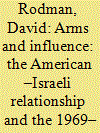

|
|
|
|
|
| Summary/Abstract |
The dominant view of the American‒Israeli relationship holds that it has been driven primarily by shared interests and values; however, since the 1960s, the relationship has been governed first and foremost by a ‘security-for-autonomy’ bargain. Under the terms of this bargain, Washington has obtained a significant amount of influence over Israeli foreign policy in exchange for American arms transfers to Israel. The 1969‒1970 War of Attrition clearly illustrates how this bargain has operated in practice. The United States manipulated Israeli military conduct in a manner that accommodated American national interests by withholding or supplying arms at key junctures of the war.
|
|
|
|
|
|
|
|
|
|
|
|
|
|
|
|
| 2 |
ID:
139209
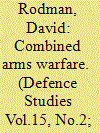

|
|
|
|
|
| Summary/Abstract |
Traditional combined arms warfare is premised on the assumption that a symmetrical mix of different kinds of units and weapons offers an army the best prospect of achieving optimal results on the battlefield. The Israel Defense Forces (IDF) has been accused by critics over the years of essentially abandoning the practice of traditional combined arms warfare before the 1973 Yom Kippur War in favor of a nontraditional (asymmetrical) variant that relied much too heavily on tanks and aircraft. While this criticism certainly has substantial merit, the IDF’s reverses in the early days of the war were not due solely to a lack of emphasis on traditional combined arms warfare, but rather also to a “perfect storm” of circumstances that obtained at the outset of hostilities. To its credit, the IDF learned rapidly from its prewar mistakes in force structure and war-fighting doctrine, reverting within days to a traditional approach to the practice of combined arms warfare, at least on the ground. Though not a battlefield panacea by any means, traditional combined arms warfare clearly contributed to the IDF’s eventual victory in the war.
|
|
|
|
|
|
|
|
|
|
|
|
|
|
|
|
| 3 |
ID:
145238
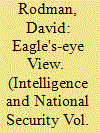

|
|
|
|
|
| Summary/Abstract |
The United States displayed a keen interest in the nature, progress and results of the Yom Kippur War, because the fighting was thought to reflect how non-nuclear hostilities between the North Atlantic Treaty Organization (NATO) and the Warsaw Pact (WP) would unfold on the plains of central Europe in case war broke out there. In contrast to many observers of the war, who concluded that the losses suffered by the Israel Defence Forces (IDF) at the hands of Egyptian and Syrian anti-aircraft and anti-tank weapons had rendered the aircraft and the tank largely impotent, thereby revolutionizing how wars would be waged in the future, Central Intelligence Agency (CIA) analysts and United States Army Training and Doctrine (TRADOC) Command officers, based upon an in-depth review of the nature, progress and results of the fighting, re-affirmed the centrality of these weapons systems on the modern battlefield. Rather than focus obsessively on technological developments, they concluded that training, leadership and tactics were ultimately the decisive elements in the Yom Kippur War.
|
|
|
|
|
|
|
|
|
|
|
|
|
|
|
|
| 4 |
ID:
093971
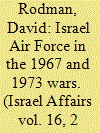

|
|
|
|
|
| Publication |
2010.
|
| Summary/Abstract |
The Israel Air Force (IAF), according to conventional wisdom, constituted the decisive element in Israel's victory in the 1967 Six Day War, but had much less of an impact on the state's triumph in the 1973 Yom Kippur War. The present article takes issue with this line of thinking, contending that, while the IAF's contributions to the Israeli victories in both wars were quite significant, airpower actually was more important in the latter triumph, but not decisive in either one. The article reaches this conclusion through an in-depth comparison of the IAF's accomplishments (or lack thereof) in both wars.
|
|
|
|
|
|
|
|
|
|
|
|
|
|
|
|
| 5 |
ID:
159436
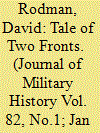

|
|
|
|
|
| Summary/Abstract |
Caught by surprise by the Syrian and Egyptian armies at the outset of the 1973 Yom Kippur War, the Israel Defense Forces (IDF) experienced serious reverses on both the Golan and Sinai fronts during the early days of hostilities but recovered more quickly in the north than in the south. The Israeli government’s prioritization of the Golan front early in the war and the cumulative effects of at least six other variables—terrain, frontline forces, command and control (C2), reserve mobilization, airpower, and combined arms warfare—explain the IDF’s better performance in the north during the early days of the conflict.
|
|
|
|
|
|
|
|
|
|
|
|
|
|
|
|
|
|
|
|
|